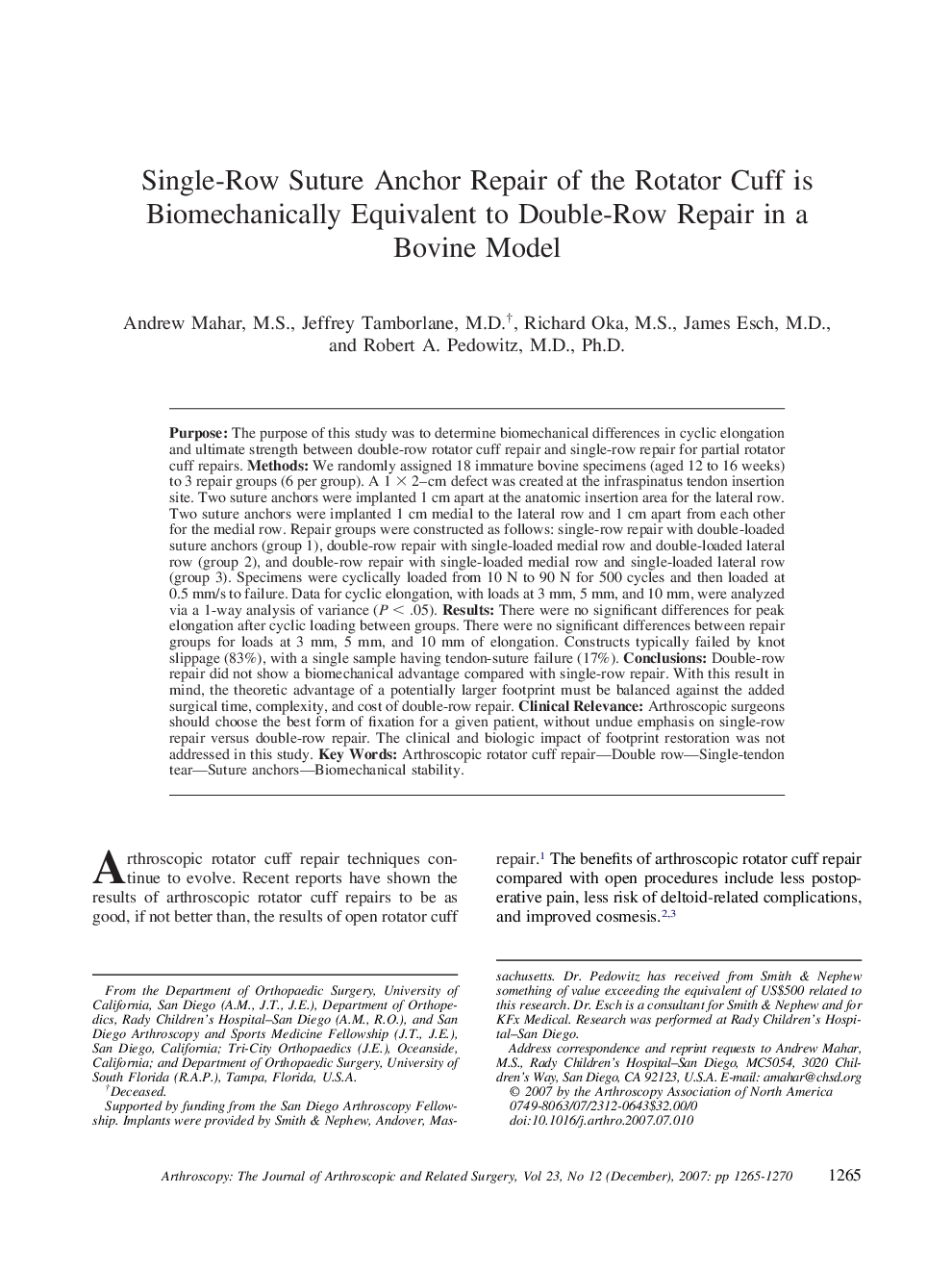| کد مقاله | کد نشریه | سال انتشار | مقاله انگلیسی | نسخه تمام متن |
|---|---|---|---|---|
| 4045299 | 1603590 | 2007 | 6 صفحه PDF | دانلود رایگان |
عنوان انگلیسی مقاله ISI
Single-Row Suture Anchor Repair of the Rotator Cuff is Biomechanically Equivalent to Double-Row Repair in a Bovine Model
دانلود مقاله + سفارش ترجمه
دانلود مقاله ISI انگلیسی
رایگان برای ایرانیان
کلمات کلیدی
موضوعات مرتبط
علوم پزشکی و سلامت
پزشکی و دندانپزشکی
ارتوپدی، پزشکی ورزشی و توانبخشی
پیش نمایش صفحه اول مقاله

چکیده انگلیسی
Purpose: The purpose of this study was to determine biomechanical differences in cyclic elongation and ultimate strength between double-row rotator cuff repair and single-row repair for partial rotator cuff repairs. Methods: We randomly assigned 18 immature bovine specimens (aged 12 to 16 weeks) to 3 repair groups (6 per group). A 1 Ã 2-cm defect was created at the infraspinatus tendon insertion site. Two suture anchors were implanted 1 cm apart at the anatomic insertion area for the lateral row. Two suture anchors were implanted 1 cm medial to the lateral row and 1 cm apart from each other for the medial row. Repair groups were constructed as follows: single-row repair with double-loaded suture anchors (group 1), double-row repair with single-loaded medial row and double-loaded lateral row (group 2), and double-row repair with single-loaded medial row and single-loaded lateral row (group 3). Specimens were cyclically loaded from 10 N to 90 N for 500 cycles and then loaded at 0.5 mm/s to failure. Data for cyclic elongation, with loads at 3 mm, 5 mm, and 10 mm, were analyzed via a 1-way analysis of variance (P < .05). Results: There were no significant differences for peak elongation after cyclic loading between groups. There were no significant differences between repair groups for loads at 3 mm, 5 mm, and 10 mm of elongation. Constructs typically failed by knot slippage (83%), with a single sample having tendon-suture failure (17%). Conclusions: Double-row repair did not show a biomechanical advantage compared with single-row repair. With this result in mind, the theoretic advantage of a potentially larger footprint must be balanced against the added surgical time, complexity, and cost of double-row repair. Clinical Relevance: Arthroscopic surgeons should choose the best form of fixation for a given patient, without undue emphasis on single-row repair versus double-row repair. The clinical and biologic impact of footprint restoration was not addressed in this study.
ناشر
Database: Elsevier - ScienceDirect (ساینس دایرکت)
Journal: Arthroscopy: The Journal of Arthroscopic & Related Surgery - Volume 23, Issue 12, December 2007, Pages 1265-1270
Journal: Arthroscopy: The Journal of Arthroscopic & Related Surgery - Volume 23, Issue 12, December 2007, Pages 1265-1270
نویسندگان
Andrew M.S., Jeffrey M.D., Richard M.S., James M.D., Robert A. M.D., Ph.D.,